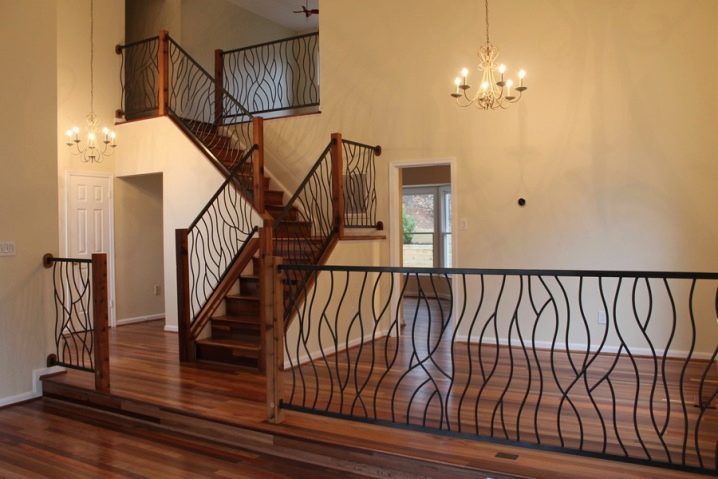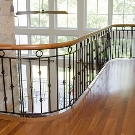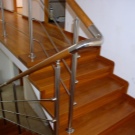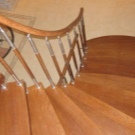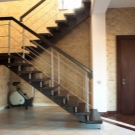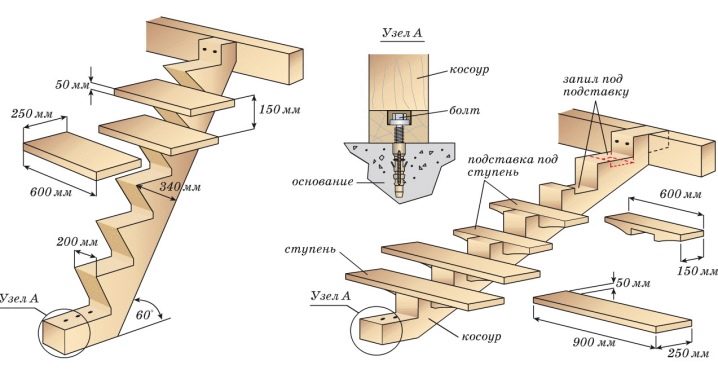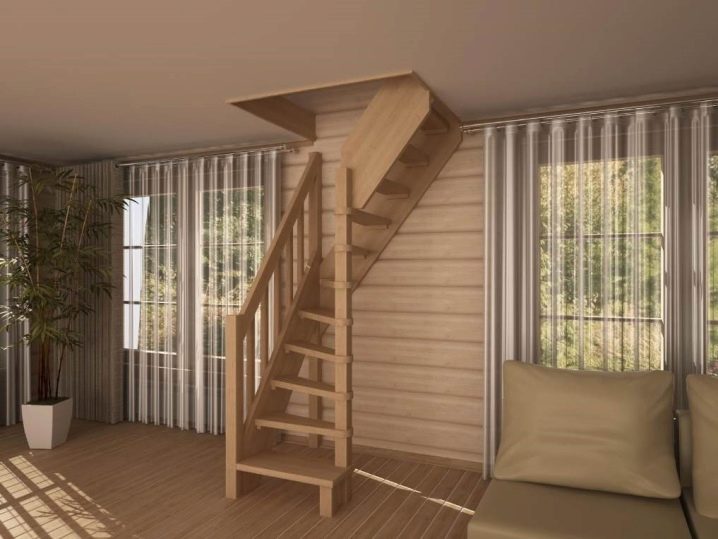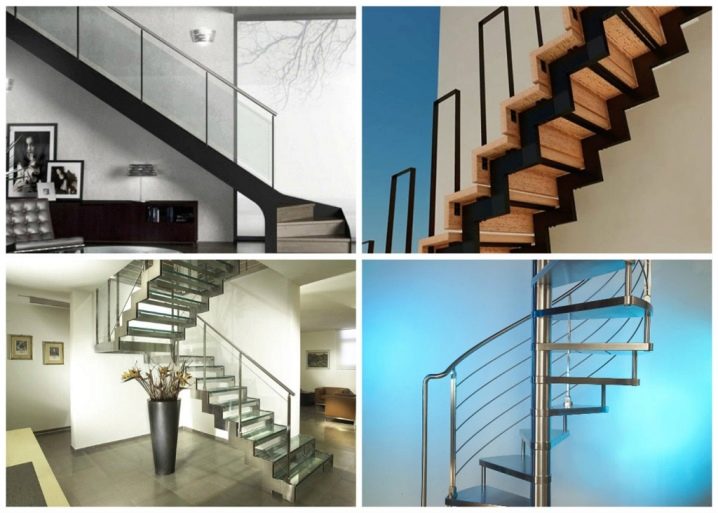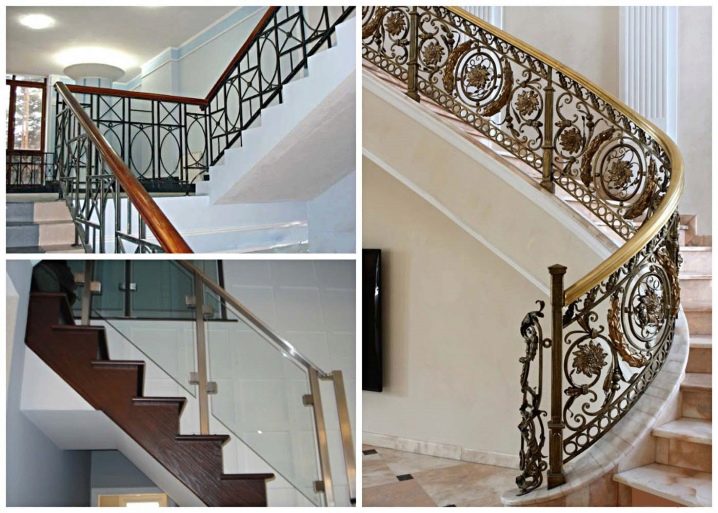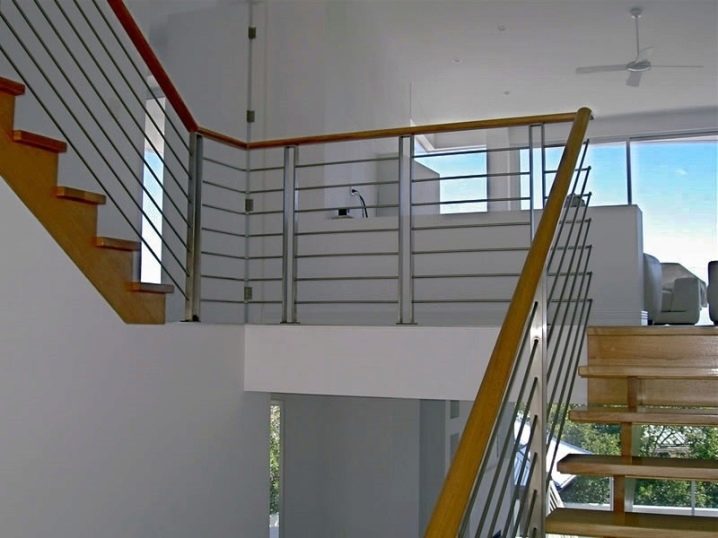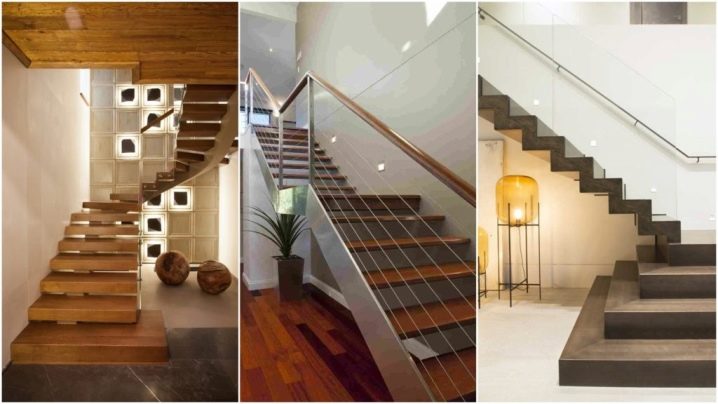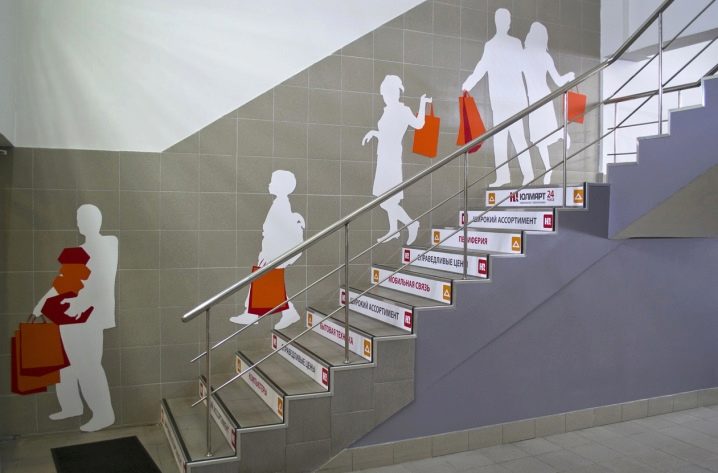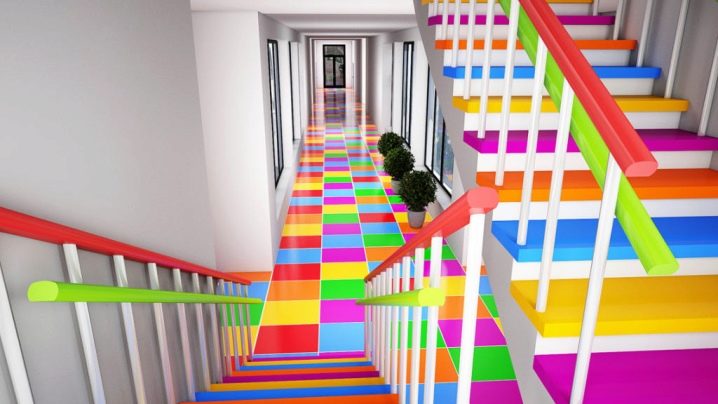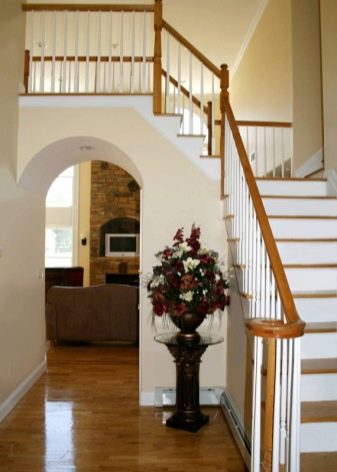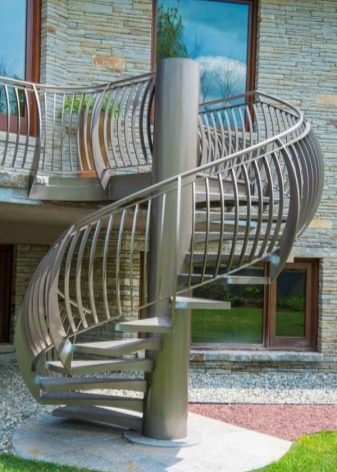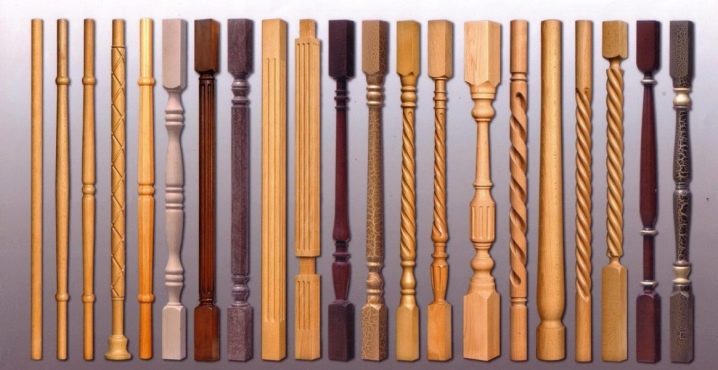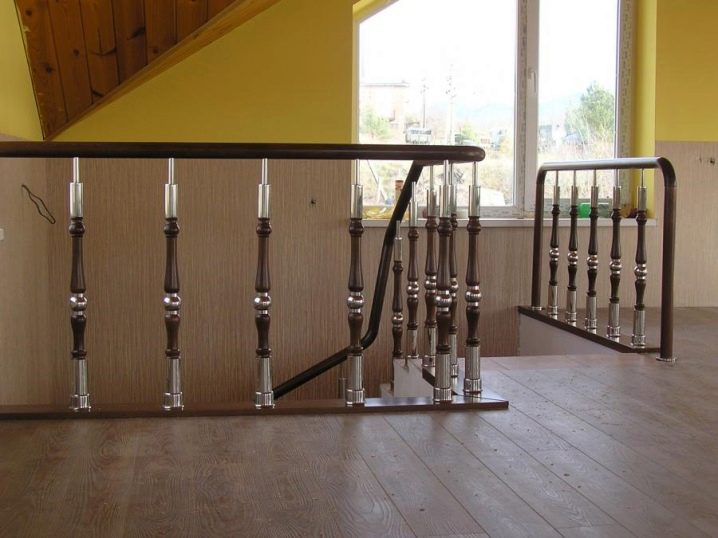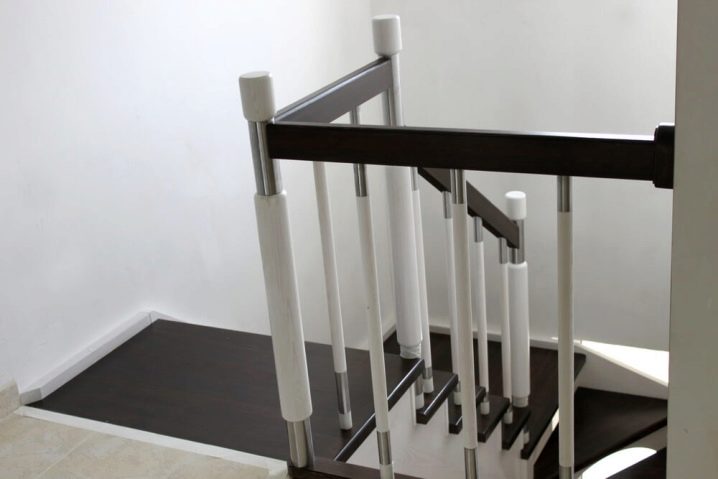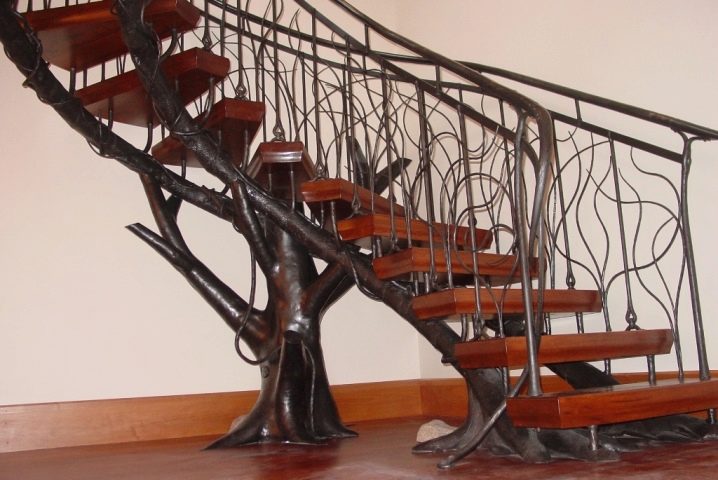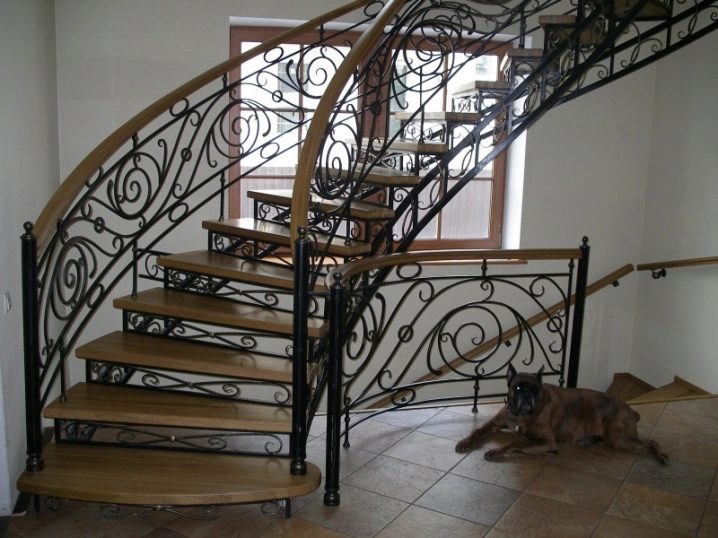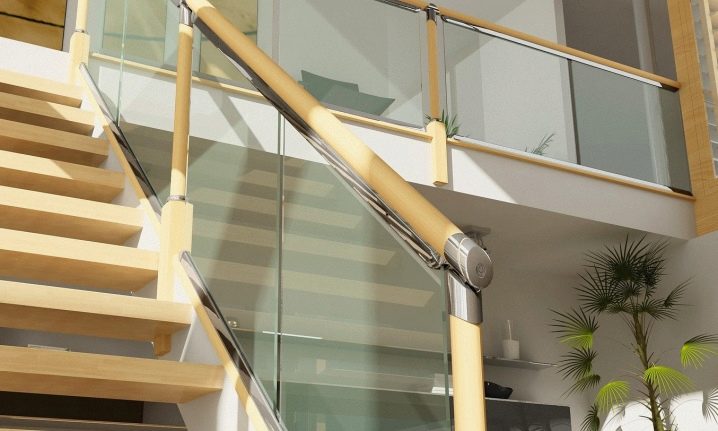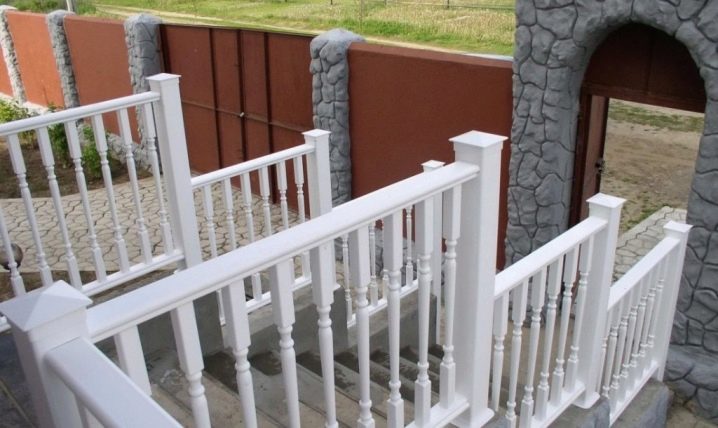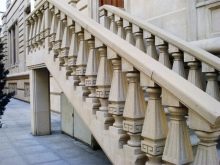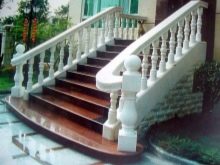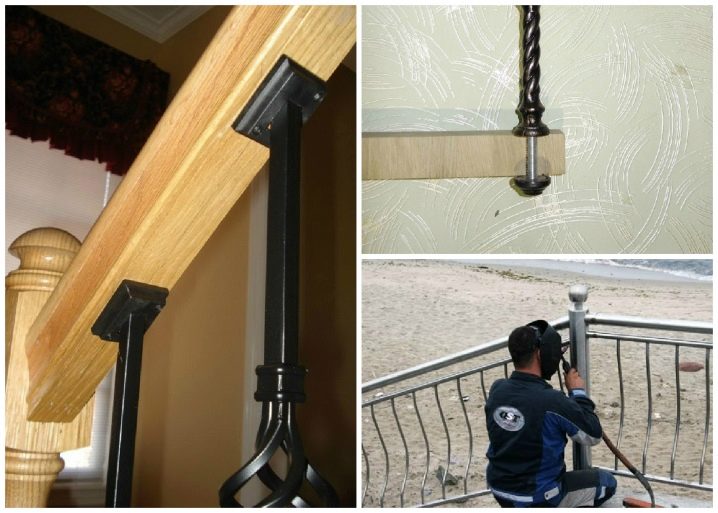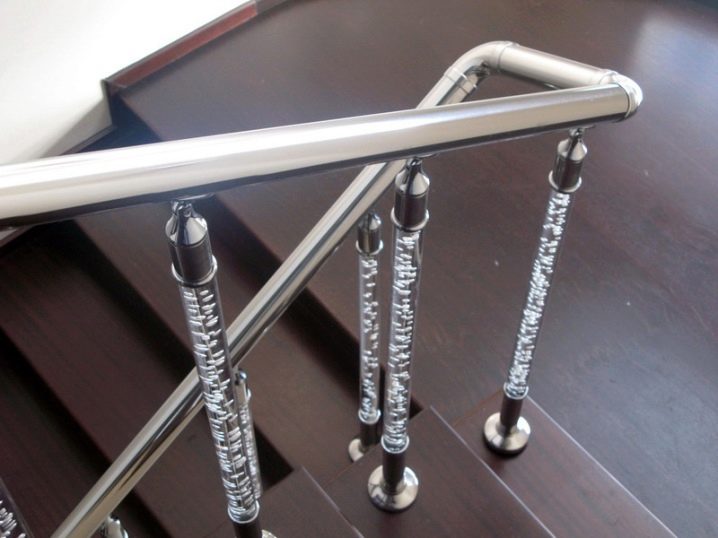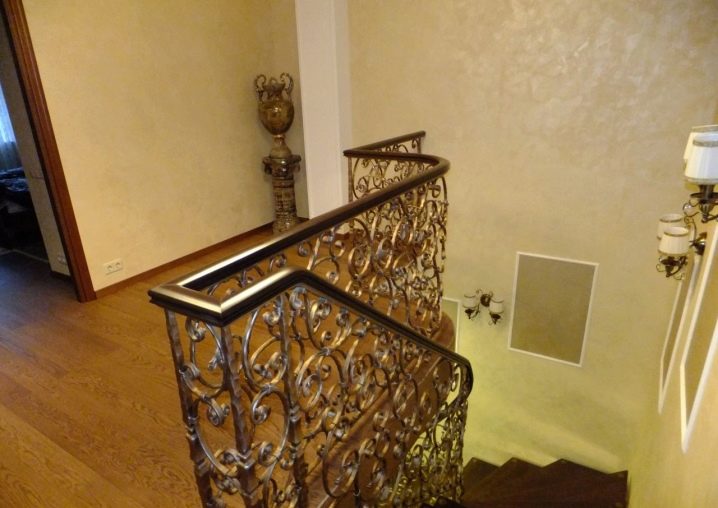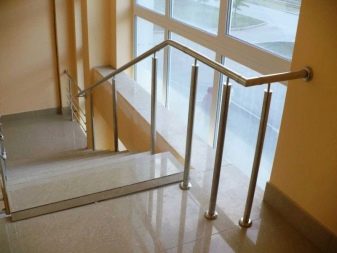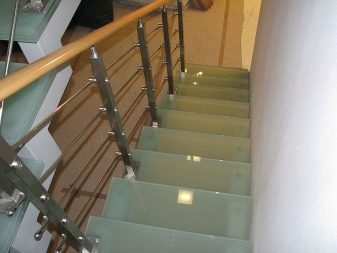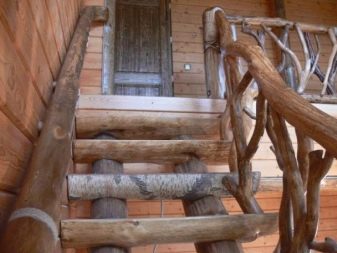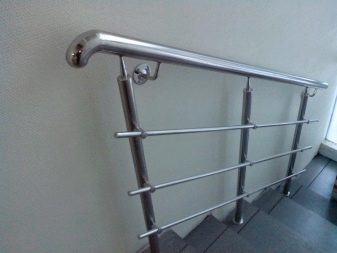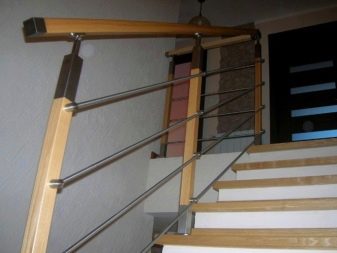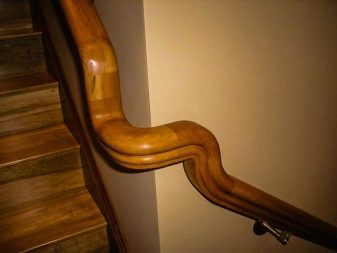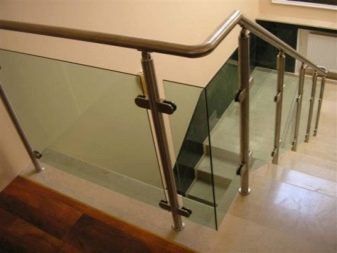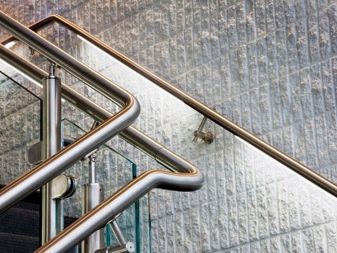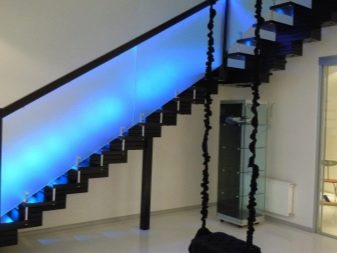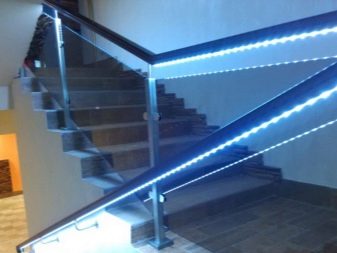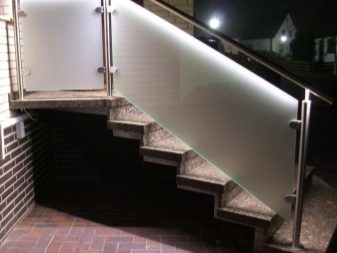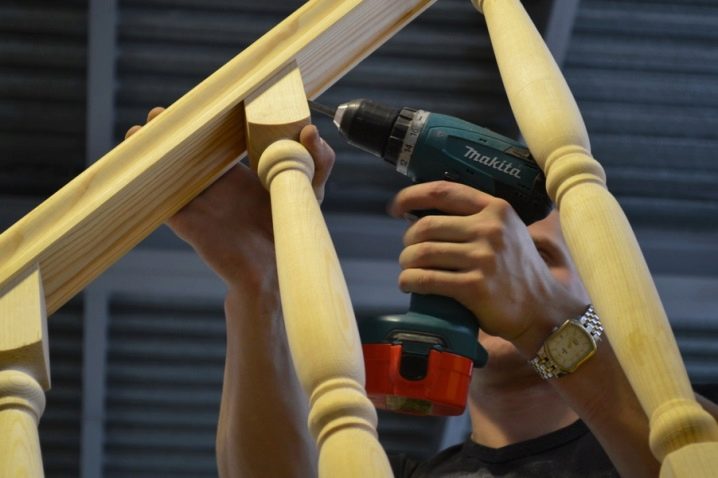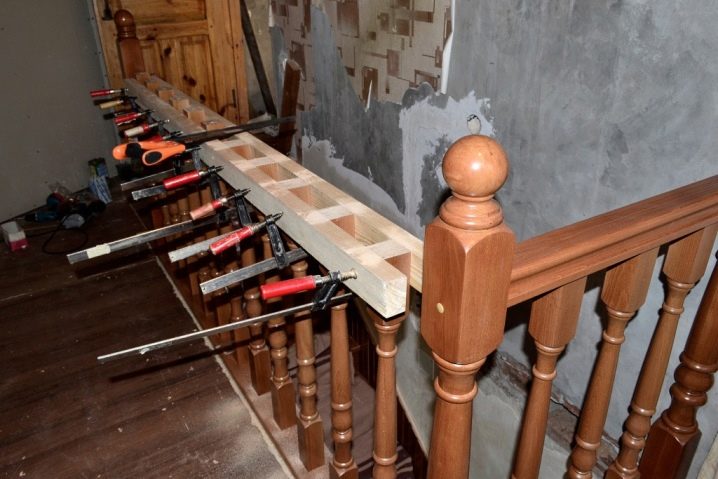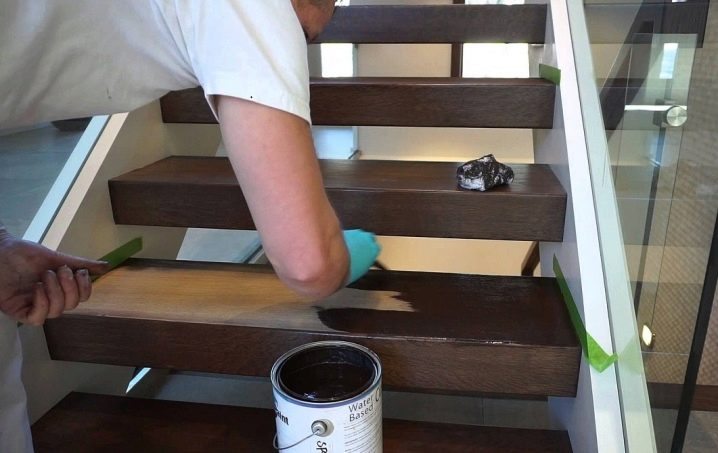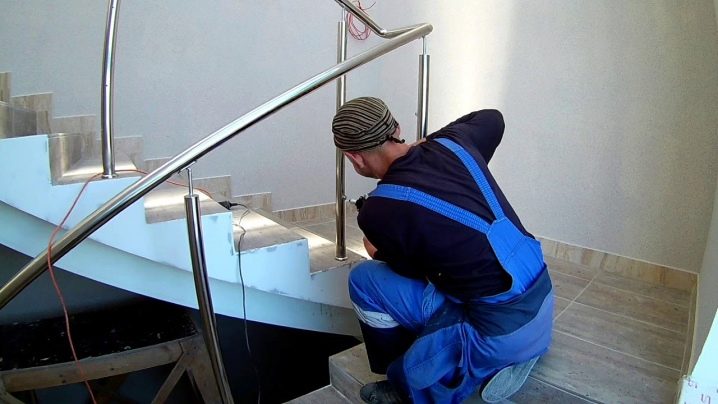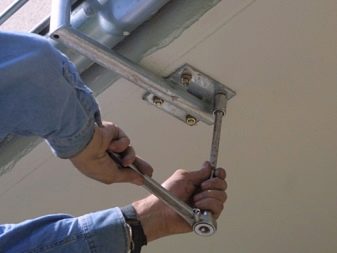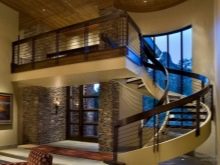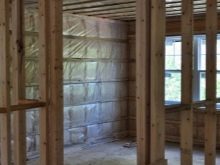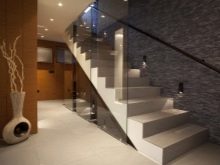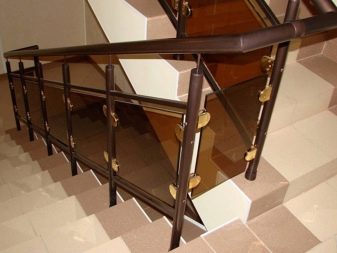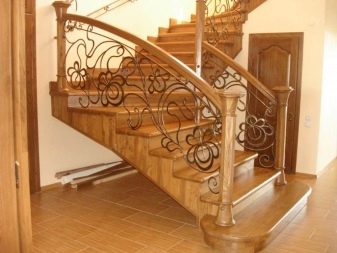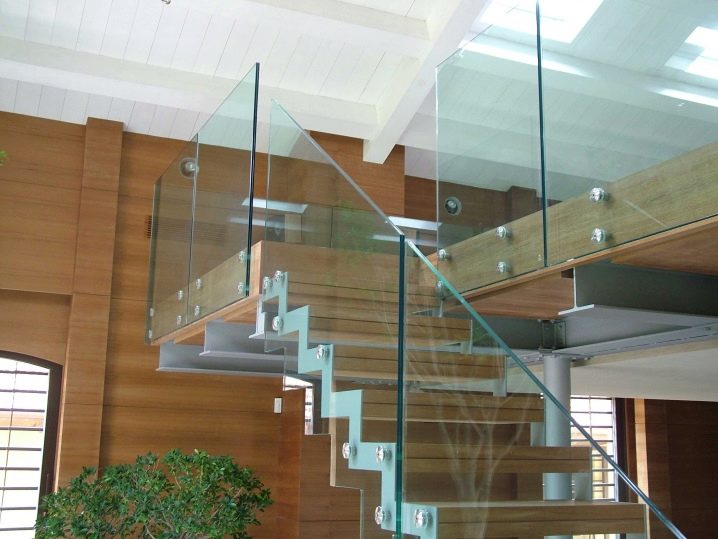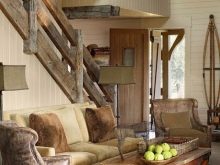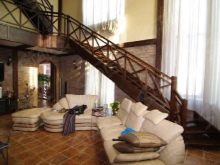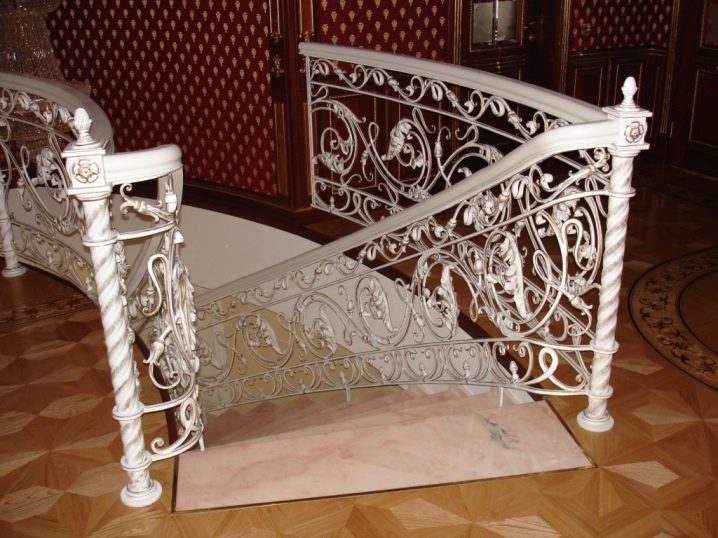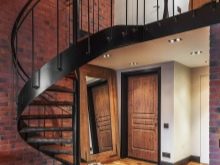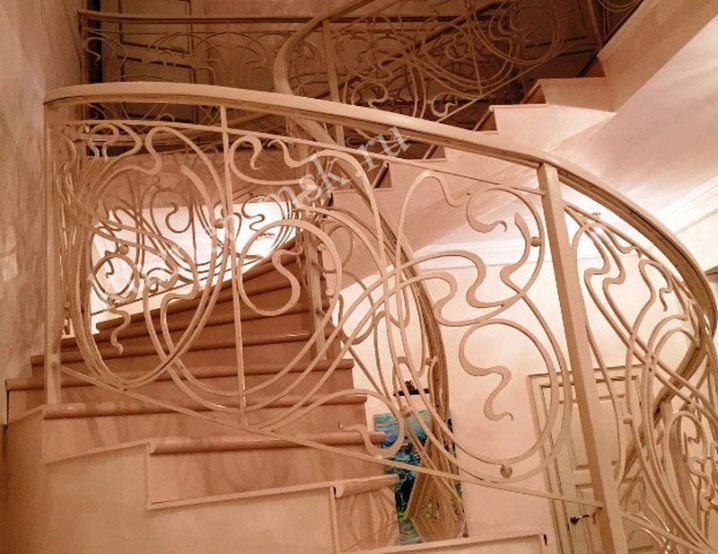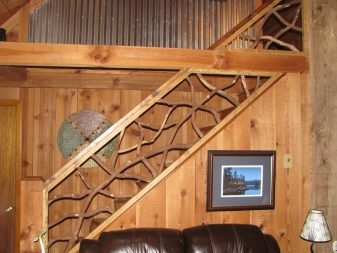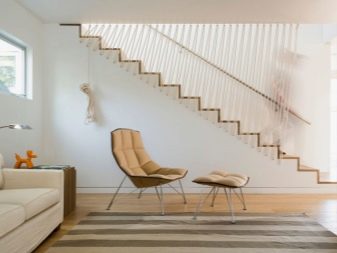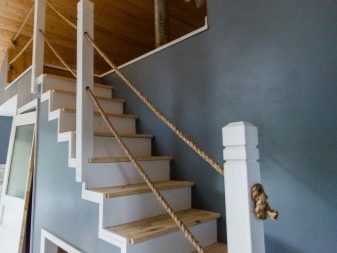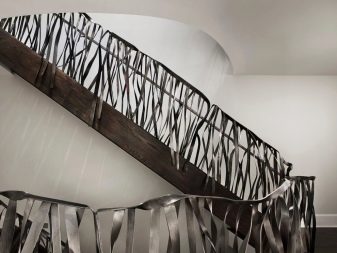How to choose and install handrails and railings for stairs in a private house?

Obligatory attribute of any flight of stairs are fences and railings. They appeared in antiquity, and nowadays they are used literally everywhere. However, the proper choice of railings requires certain skills and knowledge, since they must also differ for different buildings.
Special features
The question of how the staircase will look and from what it will be constructed should be solved at the design stage. It is extremely important to choose the optimal material, design and shape of the future design, which should be safe, functional and stylish.
Today, there are several basic types of ladder structures:
- marching flights;
- straight stairs;
- curved structures;
- swivel stairs;
- screw devices;
- curvilinear;
- combined.
When designing stairs, there are several basic requirements:
- After every 9-10 steps it is advisable to equip small platforms where you can relax and catch your breath.
- The minimum width of the steps should be 80 cm — optimally, if 2 people are free to disperse on one step.
- Comfortable for lifting the height of the steps is 15-20 cm, and the depth is better to construct in the range of 25-30 cm.
- Staircases must be wider than the flight of stairs.
- The whole structure should be inclined to a maximum of 45 degrees, and it is better if this parameter is in the range of 25-30 degrees, otherwise the movement will be unsafe.
- Steps and other elements of the ladder must be combustible, for this the materials used must be treated with special fire retardants.
- The elevation angle is steeper, the smaller the area allocated for the construction of the stairs.If the space is very small, then the staircase will be spiral with a large number of turns and bends - this variant is often resorted to for arranging a country house.
Mandatory element of any staircase are the railing. They perform very important functions - they make the descent / ascent comfortable and safe and are a stylish element of the design that favorably emphasizes the overall design decision of the interior and exterior.
Many believe that such barriers are required only for the elderly, sick people and families with children, since it is these categories of users who have the greatest problems with sustainability. And this is a fundamentally wrong approach - even an adult needs a sense of security, which is why the railing should be mounted on all types of stairs without exception, so that anyone, even an adult and completely healthy, can grab them in case of an unforeseen situation.
In addition to providing convenience, railings perform an aesthetic function. They can be dark or light, with or without thread, angular, rounded, wooden, glass or wrought.The railing can be mounted on the steps, and can be mounted in the walls - this diversity allows you to realize any design ideas and emphasize the conceptual style.
From a technical point of view, railings are vertically positioned structures that are attached along the edge of a flight of stairs. They include several basic elements:
- The basis of the fence, its support - This is the so-called baluster. It connects the steps with the handrail and ensures safe movement throughout the structure.
- Fill placeholder - These are materials that are mounted between the balusters. They can perform a decorative function, but where children constantly descend and rise, such barriers are mandatory.
- Handrails - serve as a support device for humans. As a rule, they are attached to the wall or baluster.
In addition, all types of fillers have their own classification. So, according to the version they can be:
- classic - that is, those that consist of vertically positioned or inclined bars, most often they are called figured;
- solid - very often, to ensure greater safety and prevent falls, solid panels are mounted that are attached to the balusters;
- latching - This is a design in which the vertical strips intersect with each other horizontal;
- patterned - this is an artistic filling that can look like anything in accordance with the individual design of the user.
Elements of fencing and decoration of openings can be combined to create stylish and spectacular combinations. In rare cases, balusters are replaced by a string - these are horizontal barriers that are mounted under the handrails parallel to the movement of a person. Some railings have a cap, which is also called a curbstone - this is a part that is installed at the beginning and end of a flight of stairs instead of balusters. This is a purely decorative design that has no practical functionality.
Today the market offers a variety of ready-made prefabricated models. However, if you wish, everyone can do it himself or order the professionals their own "exclusive" stairs.
Standards and standards
Stair rails are used to move as safely as possible, they serve as a fence and reduce the risk of injury. Designers sometimes install models without railings, which, of course, look very interesting, but using such a design is a bit uncomfortable. There are certain standards that regulate the dimensions of the railing. Their height should be determined individually based on the growth of the inhabitants of the house.
To make the construction as comfortable as possible, you can conduct an empirical experience - going down the stairs, you have to stretch your arm forward and measure the distance from it to your foot - this size will be the optimal height of the railing for you.
Traditionally, the minimum height of the handrail is 90 cm, and the largest is 110 cm. If there are children in the family, then it makes sense to make 2 types of handrails located at different heights. Their standards are valid for children's institutions: for schools and other places where children are, it is recommended to install double barriers at a height of 90 and 50 cm.
As for the width, they are usually produced in size from 3 to 7 cm - they must be such that they can be grasped and held free.The distance between the balusters is determined by the artistic intent of the building owners, however, experts do not recommend making a step more than 0.5 m in length.
Designers give some simple recommendations on the arrangement of the structural elements of the railing:
- The number of balusters should be dictated by the dimensions of the handrail. If flexible or heavy materials are used, then the number of supports should be such that no profile sags or excessive support overloads occur.
- In the classic version, balusters are fixed on each step, and sometimes even several supports on one step. If there are small children in the house, as well as in children's institutions, the distance between them should not exceed 15 cm - this will protect the little ones from the risk of falling out.
- If the width of the flight of stairs exceeds one meter, it is recommended to install the railing on both sides.
- Wooden railing equip only in residential areas.
- In office buildings it is recommended to install a string instead of balusters.
- When arranging a shopping complex, you should use at least three railings.
Fencing
As already saidrailing options for arranging stairs a great many. A large variety is achieved through the use of different materials, colors and mounting options. Therefore it is worthwhile to dwell separately on the existing types of stair railings.
Immediately, we note that all of the indicated options largely depend on the location of the flight of stairs. There are the following types of railings:
- Interior - that is, those that are located indoors. As a rule, they are decorated in light shades, and the base material is glass or wood.
- Exterior - These are stairs that are located outside the premises, for example, on the porch. In this case, dark colors prevail, and metal and batons are used as materials.
The shape of the railing depends on the localization of the span; in addition, the manufacturing material has a great influence on it. So, the tree is more often used to implement the ideas of classical design - balusters in the form of straight columns are quite massive, the handrail has rounded edges. The metal railing has a miniature handrail, but the balusters are abundantly decorated with decorative elements, while glassware is distinguished by its strict concise design.
Tree
Despite the abundance of materials on the market, the popularity of wooden railing does not fall off and this is easily explained - consumers always strive for maximum naturalness and environmental friendliness of their homes. They have a stylish appearance and attractive texture, are resistant to mechanical damage, easily tolerate all types of negative external influences. This largely explains the fact that wooden railings are widely used for decorating facade elements.
In addition, the stores are widely represented by different wood species in different price segments, so everyone can buy raw materials based on their financial capabilities. Usually, more expensive woods are used inside the house, and outside they prefer budget options.
Metal
Stainless steel or aluminum railings are widespread, nickel-plated and brass are a little less popular. The peak of their popularity was at the beginning of our century, then they were installed everywhere in large retail and office complexes and business centers. The interest in such railings has not disappeared even nowadays, this is due to the exceptionally high performance characteristics of such structures:
- Long term use. Metal railing can serve at least 50 years.
- Aesthetics - giving the design a stylish and modern look.
- Easy maintenance - metal products do not need regular tinting and varnishing, they do not need to be treated with protective compounds and flame retardants. All that is needed to care for them is only to wash periodically with plain water.
- Resistance to corrosion. Stainless steel, like aluminum, is resistant to rust, thanks to this property, they can be mounted both inside the building and outside. If we talk about stainless steel railings, then another advantage will be an affordable price, which is much lower than analogs made of glass or forging.
As for the minuses, it is one - after a long time of use, the material’s resistance to mechanical damage decreases and numerous scratches and chips appear on the surface of the railing, and their attachment points often become loose. However, this does not apply to aluminum railings - they retain strength and strength for many years.
More expensive, but a quality option are forged railing.When choosing such a material, the leading factor is the exceptional grace of such products and beauty.
The production of forged stair railing is made using several technologies:
- Cold forging allows you to create products of the simplest form, twisting rods. As a rule, this option is preferable for the railing on the porch and other types of outdoor stairs.
- Hot forging takes longer time, but the products thus turn out to be the most intricate and ornate. With the help of the hot method, you can create the most complex structures that are often installed in large comfortable cottages or hotels.
The advantages of wrought iron railings are not in any doubt, among them:
- resistance to external adverse effects - forged railings perfectly tolerate fluctuations in temperature, rain, hail and snow, and also show resistance to mechanical damage;
- long service life - fences can serve faithfully for up to 100 years;
- exceptional design - manufacturing technology forged products allows you to equip the railing for any individual sketches, such a product is always exclusive.
The lack of wrought iron railings is only one - they are very expensive.
Glass
Stylish and modern solution for those who prefer minimalism in the interior. Despite the external fragility, these beautiful railings have a large number of advantages:
- simplicity and high speed of installation - railings and handrails can be installed in a couple of days, and the installation process itself is not complex and highly adaptable;
- large selection of different design options - sound-proof, explosion-proof and frost-resistant models, as well as fireproof and bullet-proof modifications are widely represented on the market;
- durability - glass fences can be used for 50 years;
- easy disassembly - in the event of a deformation, any section can be replaced without the need to change the entire enclosure as a whole.
Such rails and flaws are not deprived. These include the complexity of service and the high cost of such products.
Plastic
Polymeric composite railings are made of very hard plastics and WPC, fixed on a special mount. The advantage of polymers is their price.The cost of plastic railings is an order of magnitude lower than all other options for arranging stairs. However, the advantages of plastic are not limited to this. This material is easy to clean, it is easy to clean and wipe, does not require regular treatment with varnishes, paints and flame retardants.
The material is resistant to damage of weak force, but any strong blow can damage them. However, this statement applies to most materials.
Concrete
Concrete railings, like the stone version, are used rather rarely, since such structures are rather heavy, and if we talk about stone, they are still very expensive. At the same time, their strength and strength is extremely high, which is why their main scope of application is the arrangement of staircases and porch.
They are not afraid of any adverse atmospheric effects, but they look more than presentable, emphasize the style of the exterior, as well as the status of the owner of the building.
Stone balusters are also very popular. Depending on the characteristics of their manufacture, there are:
- carved balusters - usually made by hand, therefore, as a rule, they are distinguished by exquisite shapes and a variety of patterns;
- point - the most common type, characterized by roundness of forms and a diverse distribution of thickenings, it is easy to recognize them - the horizontal section of the point supports are circular;
- hewn - such columns have pronounced even edges, their shape is rather angular, and the horizontal section resembles a polygon.
As for materials, marble, Dagestan or artificial stone, as well as granite are used to decorate the railing. The latter gives the strongest support, because this stone is one of the hardest rocks. Stone railings look very attractive, they emphasize the luxury and nobility of interior design of the premises, however, they create an additional load on the flight of stairs. This must be taken into account when designing the stairs.
Stone supports are perfectly combined with the stairs of the boards or metal steps. Such combinations favorably refresh the design and give the room a more residential and well-maintained look.
Upper supporting elements
Any railings must necessarily be equipped with "tops" - handrails, otherwise their use will be unsafe.There are a variety of embodiments of the upper support elements of the railing.
In shape and material
If we talk about the shape, the handrails can be presented in a variety of ways: round, rectangular, square, oval, angular or rounded. Depending on the purpose of the ladder, you can choose the most advantageous material for its production. So, forged porches are most preferred forged or chrome-plated profiles, as well as stainless steel options.
PVC handrails in their performance characteristics are similar to metal, but the exterior is more like wooden elements. Their main advantage is high plasticity, which allows you to give the handrails any shape when exposed to warm air (for example, when heated with a building dryer). Another advantage is low cost.
For many years at the peak of popularity handrails made of wood. Such non-falling interest is largely due to the special atmosphere of coziness that wooden elements bring to any house. Sometimes the quality of their production is so exceptional that the handrails can even be called a work of art.
At the place of attachment
Depending on the type of fastening, you can distinguish two-types of railings:
- over the string;
- handrails with carrier function.
As a rule, handrails are mounted to balusters using anchors and screws, as well as by the welding method - this depends on the material used. The fixing of the handrails on the wall along the line of the stairs is carried out with the help of special cast brackets, which can grip the bar anywhere or from the end.
Custom solutions
To create an individual design and maintain an atmosphere of coziness and comfort in country houses are often set unconventional handrails of improvised means. A little rough handrails from raw logs look very aesthetically and stylishly. Such an element can place the necessary accents in the room and emphasize the reasonableness of its interior.
The handrails of the branches in combination with polycarbonate look quite nontrivial - this allows you to implement the principles of minimalism in the design of premises. But fans of the marine theme can recommend options from a rope or a thick rope, which will look harmoniously both in the house and in the country.
Original handrails are favored by an increasing number of homeowners. Among the most popular options:
- light wood handrails in a continuous line;
- straight oak bar, which is attached with metal clamps;
- a combination of glass and chrome sheets with wooden edging;
- uniform alternation of vertical and horizontal lines - as a rule, this option is used for wooden or metal structures;
- pipes made of steel, fixed parallel to each other with curved sections of turns.
Against the background of dark walls, the railings look quite unusual with illumination, while the power is supplied directly to the handrails.
The most common designs:
- stainless steel railings and illuminated handrails. It is embedded in the handrail in the form of an LED strip, it “breaks through” at the corners, and a brass cap is fixed at the end.
- Fencing made of glass with euro edge. Here the LED strip is located inside the main profile. In the basic versions, the LED has a power of not more than 4.8 W / m and has a diffusely white or color shade.
- Tubular backlight options. In this case, special remote holders are used, on which the LED strip is mounted. The power consumption also corresponds to 4.8 W / m, and a rivet is attached to the end.
- Wall railings - at the same time, both the handrail itself and the fittings are fastened using stainless steel mirror grooved pipes.
Installation
If the railings are installed with their own hands, then most often use wooden structures. This is due to the fact that the wood is fairly easy to process, and the tools that are needed for this are in the arsenal of any home craftsman.
First of all it is necessary to make a drawing of the future ladder, and only then proceed to its installation. Consider the scheme of work:
- For a start, the end cabinets are mounted - they are installed at the top and bottom of the stairs. If she has two or more marches,
- then the pedestals are fixed at every turn.
- A line is pulled between the pedestals; it indicates where the railing will be located and what the base position of the handrails will be.
- In places where they will be supported, put a markup. As already mentioned, the distance between the supports can be very different, but, as a rule, it is 15-20 cm, and if children live or stay in the house often, it should be even less.Please note that balusters are set 5-10 cm from the edge of the step.
- To achieve greater reliability, fixing them is attached directly to the stairs and bowstrings: horizontally to the first, and at right angles to the second. To increase the strength characteristics of the mount, it is recommended to additionally use mounting glue.
- At the finishing stage on the balusters install handrails. To go faster, the grooves should be pre-cleaned of dirt and remove all the dust, it will allow to achieve full smoothness.
- Finishing work with lacquering, with which you can achieve not only increased design aesthetics, but also additional wood protection This stage should be given special attention.
Among the majority of owners of private houses there is an opinion that the wooden surfaces of all types are always processed in the same way. This approach is erroneous, since the reaction of wood of different species to the same paint and varnish coating can vary greatly. For example, light varieties such as pine, it is desirable to varnish light coatings, and if it is saturated with dark stain, the result may be the most unpredictable,more often, the composition is absorbed into the tree structure unevenly and completely destroys its natural texture.
This is due to the presence of a large number of resins in the pine, it accumulates in the material non-uniformly, and therefore the areas with the highest resin content better absorb the stain, giving the material a rich dark color. At the same time, areas with a low concentration of resins remain light, creating a rather unaesthetic visual effect.
For the impregnation of wood, you should use such varnishes and paints, which advantageously shade the structure of the tree, emphasize its interesting pattern, but in no case do not hide it.
Metal railings are installed a little differently. For a start, the markings are made at the base of the railing, it is there that supports will be installed in the future. At the place of marking small holes are drilled and carefully cleaned, then the glue is poured inside and special pins are inserted.
After the adhesive has dried, you can continue to install the railing. To do this, on the previously prepared pins directly fasten the balusters by welding. In the absence of a welding machine, bolts can be used.These elements should be directed vertically.
The accuracy of the location is varied and controlled with a special level. But the handrails are directly attached to the supports, while welding is used quite rarely. Installation of metal railing requires certain skills and professional tools, since the technology is quite complex.
Fashion options
Nowadays, railings made of wood, metal, plastic and even glass are popular. Designers often combine different elements, creating a truly stylish and original designs.
By the way, many people confuse railings and handrails, so there is often a misunderstanding between the master and the customer.
Remember that the railing is the whole vertical structure, and the handrails are only their upper supporting part. Very often they are decorated with various decorative elements.
Most often, the design is made combined by combining the aesthetics of several materials, such as wood and metal or metal and glass.
Choosing the option that will be optimal in your case, you should pay attention to the overall stylistic decision of the interior and the purpose of the stairs.
The inserts of glass between the balusters look very interesting. Such ladders are optimal for the implementation of high-tech style ideas that are characterized by minimalism and conciseness.
Wooden railings can be a real decoration of the eco-house or a building, stylized as a Russian izba, as well as for interiors in the style of country or Provence.
Forging is a timeless classic. Railings with elements of forging always look advantageous and harmoniously fit into absolutely any interior design solution.
PVC allows you to create railings and handrails of any shape - this is possible thanks to the ability of plastic to bend and form curved lines.
By the way, plastic is not suitable for a classic room design, although an exception can be made for materials that mimic the texture of wood. They look really stylish and expensive.
Different styles involve the use of railings and handrails of various forms. Loft style is very fashionable in Russia.
Not far behind him modern.
Gothic have their fans too.
Non-standard materials are often used for railing equipment. For example, tree branches allow you to implement a variety of interior concepts.
Thick ropes or ropes look great in a maritime or urban style.
And some more interesting options.
How to install handrails on the stairs with your own hands, see the following video.
